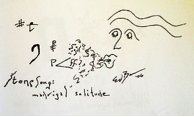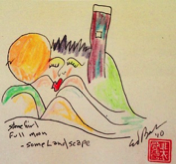| » Cover | ||
|
Reviews
Ed dropped out to restore 18th century houses (thus his Projectivist gem, Restoration Poems), i.e. in order to be a builder, a maker who draws the past into the present. He does that still, in widening ways. His house in Takoma Park is a beautiful, mad place packed with paintings, multimedia, painted stones and other objects found on visionary walks. His big book is a portable version of that house. Stone Girl E-Pic works out an improbably marriage (!) of Henry Miller's sensual abandon (see too his Angel is My Watermark) and Larry Eigner's stretching of thought. Joel Oppenheimer is here, too. Some of the many visual pieces recall Kenneth Patchen and the less well-known Alex Caldiero. Here, for instance, is his Zephyrus (with no apology to Botticelli)—
Landscape/songline, face, musical notation, poem are all of a polyphonic madrigalesque piece. Or consider how the following suggests the lines of a story—
Baker reads widely and wildly, but most importantly for this book has steeped himself in Paleolithic imagery and Marija Gimbutas' The Language of the Goddess. His stone girl is at once a Paleolithic Venus, muse (any and all of the nine), deva, Stella to his Astrophel, and various contemporary women who swim, approach, draw back, and comprise the poet's world.
it is not so The stone girl is also language herself, and Baker is nothing but playful with that, delighting in writing systems—Roman, Korean, Chinese, Naxi pictograms (via Pound), emblem poetry, and Japanese haiga. There is, though, nothing scholarly about this—Baker is bawdy, at once calligrapher and graffiti artist, Patchen's shy pornographer, the crazed medieval scribe drawing mad creatures in the sacred text. Baker's motto "another perfect enso" recurs throughout the book. It calls up both plenitude and void. It also evokes the stretch of Baker's thought—the way one short poem implicates the next—stands by itself and in relation, until a grand slight off-center circle appears. Here is a page from book 5:
change Conrad Didiodato has written a superb foreword to this book, placing Stone Girl in the larger context of Baker's poetry (which should be better known) and in the wider realm of recent visual poetry. It makes for excellent pre-flight instructions; for this weighty 500-page, large-format book was made with such a light touch that it takes wing on every page. You hold on for the ride.
|
|||||


